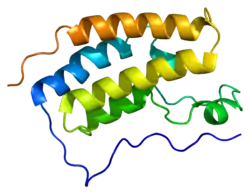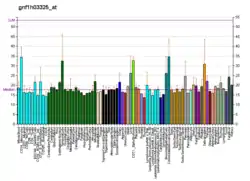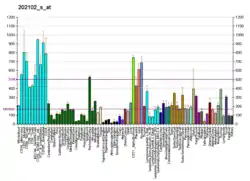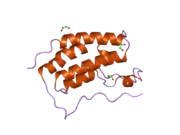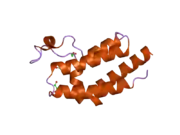Bromodomain-containing protein 4 is a protein that in humans is encoded by the BRD4 gene.[3][4]
BRD4 is a member of the BET (bromodomain and extra terminal domain) family, which also includes BRD2, BRD3, and BRDT.[5] BRD4, similar to other BET family members, contains two bromodomains that recognize acetylated lysine residues.[6] BRD4 also has an extended C-terminal domain with little sequence homology to other BET family members.[5]
Structure
The two bromodomains in BRD4, termed BD1 and BD2, consist of 4 alpha-helices linked by 2 loops.[7] The ET domain structure is made up of 3 alpha-helices and a loop.[8] The C-terminal domain of BRD4 has been implicated in promoting gene transcription through interaction with the transcription elongation factor P-TEFb and RNA polymerase II.[9][10][11]
Function
The protein encoded by this gene is homologous to the murine protein MCAP, which associates with chromosomes during mitosis, and to the human BRD2 (RING3) protein, a serine/threonine kinase. Each of these proteins contains two bromodomains, a conserved sequence motif which may be involved in chromatin targeting. This gene has been implicated as the chromosome 19 target of translocation t(15;19)(q13;p13.1), which defines the NUT midline carcinoma. Two alternatively spliced transcript variants have been described.[4]
Role in cancer
Most cases of NUT midline carcinoma involve translocation of the BRD4 gene with NUT genes.[12] BRD4 is often required for expression of Myc and other "tumor driving" oncogenes in hematologic cancers including multiple myeloma, acute myelogenous leukemia and acute lymphoblastic leukaemia.[13]
BRD4 is a major target of BET inhibitors,[13][14] a class of pharmaceutical drugs currently being evaluated in clinical trials.
Interactions
Notably, BRD4 interacts with P-TEFb via its P-TEFb interaction domain (PID), thereby stimulating its kinase activity and stimulating its phosphorylation of the carboxy-terminal domain (CTD) of RNA polymerase II.[15] Recent review.[16]
BRD4 has been shown to interact with GATA1,[17] JMJD6,[18] RFC2,[19] RFC3,[19] RFC1,[19] RFC4[19] and RFC5.[19]
BRD4 has also been implicated in binding with the diacetylated Twist protein, and the disruption of this interaction has been shown to suppress tumorigenesis in basal-like breast cancer.[20]
BRD4 has also been shown to interact with a variety of inhibitors, such as MS417; inhibition of BRD4 with MS417 has been shown to down-regulate NF-κB activity seen in HIV-associated kidney disease.[21] BRD4 also interacts with apabetalone (RVX-208),[22] which is being evaluated for treatment of atherosclerosis and cardiovascular disease.
References
- 1 2 3 GRCh38: Ensembl release 89: ENSG00000141867 - Ensembl, May 2017
- ↑ "Human PubMed Reference:". National Center for Biotechnology Information, U.S. National Library of Medicine.
- ↑ Dey A, Ellenberg J, Farina A, Coleman AE, Maruyama T, Sciortino S, Lippincott-Schwartz J, Ozato K (Sep 2000). "A bromodomain protein, MCAP, associates with mitotic chromosomes and affects G(2)-to-M transition". Molecular and Cellular Biology. 20 (17): 6537–49. doi:10.1128/MCB.20.17.6537-6549.2000. PMC 86127. PMID 10938129.
- 1 2 "Entrez Gene: BRD4 bromodomain containing 4".
- 1 2 Zeng L, Zhou MM (Feb 2002). "Bromodomain: an acetyl-lysine binding domain". FEBS Letters. 513 (1): 124–8. doi:10.1016/s0014-5793(01)03309-9. PMID 11911891. S2CID 29706103.
- ↑ Shi J, Vakoc CR (Jun 2014). "The mechanisms behind the therapeutic activity of BET bromodomain inhibition". Molecular Cell. 54 (5): 728–736. doi:10.1016/j.molcel.2014.05.016. PMC 4236231. PMID 24905006.
- ↑ Devaiah BN, Singer DS (1 January 2013). "Two faces of brd4: mitotic bookmark and transcriptional lynchpin". Transcription. 4 (1): 13–17. doi:10.4161/trns.22542. PMC 3644036. PMID 23131666.
- ↑ Wu SY, Chiang CM (May 2007). "The double bromodomain-containing chromatin adaptor Brd4 and transcriptional regulation". The Journal of Biological Chemistry. 282 (18): 13141–5. doi:10.1074/jbc.r700001200. PMID 17329240.
- ↑ Itzen, F; Greifenberg, A. K.; Bösken, C. A.; Geyer, M (2014). "Brd4 activates P-TEFb for RNA polymerase II CTD phosphorylation". Nucleic Acids Research. 42 (12): 7577–90. doi:10.1093/nar/gku449. PMC 4081074. PMID 24860166.
- ↑ Jonkers, I; Lis, J. T. (2015). "Getting up to speed with transcription elongation by RNA polymerase II". Nature Reviews Molecular Cell Biology. 16 (3): 167–77. doi:10.1038/nrm3953. PMC 4782187. PMID 25693130.
- ↑ Yang, Z; Yik, J. H.; Chen, R; He, N; Jang, M. K.; Ozato, K; Zhou, Q (2005). "Recruitment of P-TEFb for stimulation of transcriptional elongation by the bromodomain protein Brd4". Molecular Cell. 19 (4): 535–45. doi:10.1016/j.molcel.2005.06.029. PMID 16109377.
- ↑ French CA (Jun 2010). "Demystified molecular pathology of NUT midline carcinomas". Journal of Clinical Pathology. 63 (6): 492–6. doi:10.1136/jcp.2007.052902. PMID 18552174. S2CID 2200842.
- 1 2 Da Costa, D.; Agathanggelou, A.; Perry, T.; Weston, V.; Petermann, E.; Zlatanou, A.; Oldreive, C.; Wei, W.; Stewart, G. (2013-07-19). "BET inhibition as a single or combined therapeutic approach in primary paediatric B-precursor acute lymphoblastic leukaemia". Blood Cancer Journal. 3 (7): e126. doi:10.1038/bcj.2013.24. PMC 3730202. PMID 23872705.
- ↑ Shi J, Vakoc CR (Jun 2014). "The mechanisms behind the therapeutic activity of BET bromodomain inhibition". Molecular Cell. 54 (5): 728–36. doi:10.1016/j.molcel.2014.05.016. PMC 4236231. PMID 24905006.
- ↑ Itzen F, Greifenberg AK, Bösken CA, Geyer M (Jul 2014). "Brd4 activates P-TEFb for RNA polymerase II CTD phosphorylation". Nucleic Acids Research. 42 (12): 7577–7590. doi:10.1093/nar/gku449. PMC 4081074. PMID 24860166.
- ↑ Quaresma, AJ; Bugai A; Barboric M. (2016). "Cracking the control of RNA polymerase II elongation by 7SK snRNP and P-TEFb". Nucleic Acids Research. 44 (8): 7527–7539. doi:10.1093/nar/gkw585. PMC 5027500. PMID 27369380.
- ↑ Lamonica JM, Deng W, Kadauke S, Campbell AE, Gamsjaeger R, Wang H, Cheng Y, Billin AN, Hardison RC, Mackay JP, Blobel GA (May 2011). "Bromodomain protein Brd3 associates with acetylated GATA1 to promote its chromatin occupancy at erythroid target genes". Proceedings of the National Academy of Sciences of the United States of America. 108 (22): E159–68. doi:10.1073/pnas.1102140108. PMC 3107332. PMID 21536911.
- ↑ Liu W, Ma Q, Wong K, Li W, Ohgi K, Zhang J, Aggarwal AK, Rosenfeld MG (Dec 2013). "Brd4 and JMJD6-associated anti-pause enhancers in regulation of transcriptional pause release". Cell. 155 (7): 1581–95. doi:10.1016/j.cell.2013.10.056. PMC 3886918. PMID 24360279.
- 1 2 3 4 5 Maruyama T, Farina A, Dey A, Cheong J, Bermudez VP, Tamura T, Sciortino S, Shuman J, Hurwitz J, Ozato K (Sep 2002). "A Mammalian bromodomain protein, brd4, interacts with replication factor C and inhibits progression to S phase". Molecular and Cellular Biology. 22 (18): 6509–20. doi:10.1128/MCB.22.18.6509-6520.2002. PMC 135621. PMID 12192049.
- ↑ Shi J, Wang Y, Zeng L, Wu Y, Deng J, Zhang Q, Lin Y, Li J, Kang T, Tao M, Rusinova E, Zhang G, Wang C, Zhu H, Yao J, Zeng YX, Evers BM, Zhou MM, Zhou BP (Feb 2014). "Disrupting the interaction of BRD4 with diacetylated Twist suppresses tumorigenesis in basal-like breast cancer". Cancer Cell. 25 (2): 210–225. doi:10.1016/j.ccr.2014.01.028. PMC 4004960. PMID 24525235.
- ↑ Zhang G, Liu R, Zhong Y, Plotnikov AN, Zhang W, Zeng L, Rusinova E, Gerona-Nevarro G, Moshkina N, Joshua J, Chuang PY, Ohlmeyer M, He JC, Zhou MM (Aug 2012). "Down-regulation of NF-κB transcriptional activity in HIV-associated kidney disease by BRD4 inhibition". The Journal of Biological Chemistry. 287 (34): 28840–28851. doi:10.1074/jbc.M112.359505. PMC 3436579. PMID 22645123.
- ↑ McLure KG, Gesner EM, Tsujikawa L, Kharenko OA, Attwell S, Campeau E, Wasiak S, Stein A, White A, Fontano E, Suto RK, Wong NC, Wagner GS, Hansen HC, Young PR (31 December 2013). "RVX-208, an inducer of ApoA-I in humans, is a BET bromodomain antagonist". PLOS ONE. 8 (12): e83190. Bibcode:2013PLoSO...883190M. doi:10.1371/journal.pone.0083190. PMC 3877016. PMID 24391744.
External links
- Human BRD4 genome location and BRD4 gene details page in the UCSC Genome Browser.
Further reading
- French CA, Miyoshi I, Aster JC, Kubonishi I, Kroll TG, Dal Cin P, Vargas SO, Perez-Atayde AR, Fletcher JA (Dec 2001). "BRD4 bromodomain gene rearrangement in aggressive carcinoma with translocation t(15;19)". The American Journal of Pathology. 159 (6): 1987–92. doi:10.1016/S0002-9440(10)63049-0. PMC 1850578. PMID 11733348.
- Maruyama T, Farina A, Dey A, Cheong J, Bermudez VP, Tamura T, Sciortino S, Shuman J, Hurwitz J, Ozato K (Sep 2002). "A Mammalian bromodomain protein, brd4, interacts with replication factor C and inhibits progression to S phase". Molecular and Cellular Biology. 22 (18): 6509–20. doi:10.1128/MCB.22.18.6509-6520.2002. PMC 135621. PMID 12192049.
- French CA, Miyoshi I, Kubonishi I, Grier HE, Perez-Atayde AR, Fletcher JA (Jan 2003). "BRD4-NUT fusion oncogene: a novel mechanism in aggressive carcinoma". Cancer Research. 63 (2): 304–7. PMID 12543779.
- You J, Croyle JL, Nishimura A, Ozato K, Howley PM (Apr 2004). "Interaction of the bovine papillomavirus E2 protein with Brd4 tethers the viral DNA to host mitotic chromosomes". Cell. 117 (3): 349–60. doi:10.1016/S0092-8674(04)00402-7. PMID 15109495. S2CID 14781328.
- Colland F, Jacq X, Trouplin V, Mougin C, Groizeleau C, Hamburger A, Meil A, Wojcik J, Legrain P, Gauthier JM (Jul 2004). "Functional proteomics mapping of a human signaling pathway". Genome Research. 14 (7): 1324–32. doi:10.1101/gr.2334104. PMC 442148. PMID 15231748.
- Beausoleil SA, Jedrychowski M, Schwartz D, Elias JE, Villén J, Li J, Cohn MA, Cantley LC, Gygi SP (Aug 2004). "Large-scale characterization of HeLa cell nuclear phosphoproteins". Proceedings of the National Academy of Sciences of the United States of America. 101 (33): 12130–5. Bibcode:2004PNAS..10112130B. doi:10.1073/pnas.0404720101. PMC 514446. PMID 15302935.
- Farina A, Hattori M, Qin J, Nakatani Y, Minato N, Ozato K (Oct 2004). "Bromodomain protein Brd4 binds to GTPase-activating SPA-1, modulating its activity and subcellular localization". Molecular and Cellular Biology. 24 (20): 9059–69. doi:10.1128/MCB.24.20.9059-9069.2004. PMC 517877. PMID 15456879.
- Baxter MK, McPhillips MG, Ozato K, McBride AA (Apr 2005). "The mitotic chromosome binding activity of the papillomavirus E2 protein correlates with interaction with the cellular chromosomal protein, Brd4". Journal of Virology. 79 (8): 4806–18. doi:10.1128/JVI.79.8.4806-4818.2005. PMC 1069523. PMID 15795266.
- Haruki N, Kawaguchi KS, Eichenberger S, Massion PP, Gonzalez A, Gazdar AF, Minna JD, Carbone DP, Dang TP (Jul 2005). "Cloned fusion product from a rare t(15;19)(q13.2;p13.1) inhibit S phase in vitro". Journal of Medical Genetics. 42 (7): 558–64. doi:10.1136/jmg.2004.029686. PMC 1736105. PMID 15994877.
- Schweiger MR, You J, Howley PM (May 2006). "Bromodomain protein 4 mediates the papillomavirus E2 transcriptional activation function". Journal of Virology. 80 (9): 4276–85. doi:10.1128/JVI.80.9.4276-4285.2006. PMC 1472042. PMID 16611886.
- Wu SY, Lee AY, Hou SY, Kemper JK, Erdjument-Bromage H, Tempst P, Chiang CM (Sep 2006). "Brd4 links chromatin targeting to HPV transcriptional silencing". Genes & Development. 20 (17): 2383–96. doi:10.1101/gad.1448206. PMC 1560413. PMID 16921027.
- You J, Srinivasan V, Denis GV, Harrington WJ, Ballestas ME, Kaye KM, Howley PM (Sep 2006). "Kaposi's sarcoma-associated herpesvirus latency-associated nuclear antigen interacts with bromodomain protein Brd4 on host mitotic chromosomes". Journal of Virology. 80 (18): 8909–19. doi:10.1128/JVI.00502-06. PMC 1563901. PMID 16940503.
- Sénéchal H, Poirier GG, Coulombe B, Laimins LA, Archambault J (Feb 2007). "Amino acid substitutions that specifically impair the transcriptional activity of papillomavirus E2 affect binding to the long isoform of Brd4". Virology. 358 (1): 10–7. doi:10.1016/j.virol.2006.08.035. PMID 17023018.
- Olsen JV, Blagoev B, Gnad F, Macek B, Kumar C, Mortensen P, Mann M (Nov 2006). "Global, in vivo, and site-specific phosphorylation dynamics in signaling networks". Cell. 127 (3): 635–48. doi:10.1016/j.cell.2006.09.026. PMID 17081983. S2CID 7827573.
- Abbate EA, Voitenleitner C, Botchan MR (Dec 2006). "Structure of the papillomavirus DNA-tethering complex E2:Brd4 and a peptide that ablates HPV chromosomal association". Molecular Cell. 24 (6): 877–89. doi:10.1016/j.molcel.2006.11.002. PMID 17189190.
- Schweiger MR, Ottinger M, You J, Howley PM (Sep 2007). "Brd4-independent transcriptional repression function of the papillomavirus e2 proteins". Journal of Virology. 81 (18): 9612–22. doi:10.1128/JVI.00447-07. PMC 2045424. PMID 17626100.
- Bisgrove DA, Mahmoudi T, Henklein P, Verdin E (Aug 2007). "Conserved P-TEFb-interacting domain of BRD4 inhibits HIV transcription". Proceedings of the National Academy of Sciences of the United States of America. 104 (34): 13690–5. Bibcode:2007PNAS..10413690B. doi:10.1073/pnas.0705053104. PMC 1959443. PMID 17690245.
